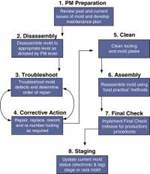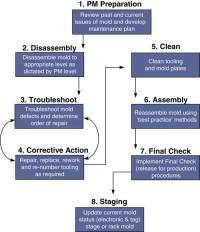Tool Room Management: How To Lead Your Team
Real progress in a mold shop won’t be made without a qualified and motivated “driver at the wheel” who diligently searches for, and implements, continuous-improvement solutions.
At our training center we preach the value proposition of being efficient in the five factors that dictate a shop’s production andcontinuous-improvement results with regard to mold performance and maintenance efficiency. The leading factor is leadership, and it occupies that spot for a reason.
Although the other four factors can drastically affect a shop’s effectiveness, real progress won’t be made without a qualified and motivated “driver at the wheel” who diligently searches for, and implements, continuous-improvement solutions for the shop. These “drivers” are the quarterbacks of their repair teams. They call the plays and then make appropriate adjustments when Murphy’s Law happens. They lead.
In fact, the amount of attention and methodology applied to the other four factors of the Star System will be a direct result of the leader’s experience, background, and management skills.
The job description for toolroom managers/supervisors carries the same basic theme regardless of the type of mold or plastic product: Keep the molds running. In today’s molding environment, many companies are realizing that leading a toolroom includes not just the ability to prioritize jobs and distribute work orders, but to move forward and make the toolroom committed to maintaining molds more safely, more accurately, and more efficiently.
In other trades, you can attend time-tested courses and earn a degree or state certification because there are proven, documented techniques for doing those jobs safely and correctly. Every electrician is taught how to wire an outlet basically the same way, utilizing “safe and correct wiring practices.” They must learn this technique and many others to pass a test and qualify as an electrician. When they get on the job site, after their work is finished, a field inspector will check to see if they properly followed the local “code” as stated in his handbook. Many of these codes must be adhered to or one risks being stripped of license and livelihood.
A mold maintenance/repair shop can be difficult to lead because there are no industry standards against which to measure the effectiveness of bench or hand-skill practices and work habits. Also, no one will be disassembling molds to see if they were properly cleaned and repaired—the only proof is in the mold performance.
HOME-GROWN STANDARDS
Since there are no documented industry standards or tooling codes for mold-repair work, exactly what constitutes “safe and correct mold-repair practices” becomes a matter of opinion or personal preference. Sometimes they are formalized in a set of Work Order Instructions (WOI) that someone may or may not follow, depending upon their opinion of the accuracy of the instructions and their mood that day.
Compounding the issue, typical mold work-order systems collect mold problems and corrective actions in journal-type formats, resulting in no real method to accurately measure the effects of different practices used during the Eight Stages of Repair (see Learn More right). So mold-performance and maintenance-practice results remain consistently … inconsistent.
This makes for a very frustrating situation and it inhibits a manager’s ability to lead effectively. How can one possibly make rational, effective decisions if they are based on ambiguous log entries, fading memory, and changing shop moods?
In the trade of mold repair, leadership usually comes in the form of a repair technician or journeyman toolmaker whose skills and experience rises above the rest and has a solid reputation in troubleshooting and repairing molds.
Hopefully, the new leader is also a good project manager and has a clear view of the larger picture of an efficiently run toolroom. But trading in one’s wrenches for a keyboard can be a major change of focus and job requirements for the guy who comes off the bench to lead a repair shop to the Promised Land.
When one spends most of his career being handed a W/O for a mold that needs to be repaired or a job that needs to be done, it is easy to get ingrained with the mindset of not analyzing molds on other benches. Just do your best on the mold to which you are assigned, clock out, and go home.
In a management position, this single focus now needs to shift dramatically to an overall shop-wide focus on how to identify and implement mold-performance and maintenance-efficiency improvements. This is a major change of thought process and some, unfortunately, are just never able to grow past the Work Order-completion mindset.
So the shop culture stays reactive, few changes are made, and the newly promoted leader, who wants to help in any way he can, now uses his repair skills to help other shop techs with specific tooling issues on their molds.
He quickly becomes the shop “go-to guy,” running down spare parts and prioritizing work needed, but he doesn’t have the time or tools to analyze mold repair costs from an administrative perspective. He continues to do what he knows best with the tools he is familiar with, only in a larger role. Bottom line—nothing really improves, initiative fades, a reactive culture persists.
LEADING IN A REACTIVE CULTURE
How can you lead in a reactive culture? You can’t. You can only “fight fires,” with work priorities being controlled by the hot jobs and unscheduled issues of the day. This type of culture is extremely frustrating to the leader who wants his shop to become more efficient and his molds to run more reliably. It can also be a boon to someone that is on cruise-control and wants no more changes or responsibility: “Just let me fix molds when they break. I’ll put my best guy on it, and all will be well.”
n order to lead effectively and change a long-standing reactive culture, toolroom managers must base more decisions on accurate data. This data not only tracks and measures high-cost issues, but qualifies specific procedures that must be followed to ensure safe and proven techniques that result in consistent and reliable mold performance. Two words come to mind: structure and accountability.
•Structure: Employ a documentation system that allows standardization of terms in a structured format. The system should ask a repair tech questions about what corrective actions were performed on a mold—not just offer a big text field for them to write in something like “fixed it” in a free-form entry. Most craftsmen hate the documentation part of the job, so anything that makes collecting the information easier will provide a huge ROI on time spent gathering data.
•Accountability: Post in the shop weekly reports that reveal the top 10 mold-stop reasons, defects, and corrective actions by frequency and repair costs (tooling and labor hours). Doing so motivates repair personnel to ensure they use the system properly as opposed to knowing that their documentation efforts are just getting filed away with little or no attention paid.
This public appraisal of shop performance will give the shop data-driven direction and also promote the professional discipline required to focus when no one is looking over your shoulder. It is amazing how many issues seem to disappear simply because the leader is now actively engaged in recognizing and posting mold performance and maintenance efficiency issues.
Real improvement in maintenance efficiency and shop culture won’t come by merely changing cloned leaders. The key is to accurately identify what issues need to be addressed; optimize bench time on molds; and make sure specific procedures are qualified, documented, and followed. Not an easy job, but would you want one that just anyone could do?
Related Content
The Effects of Stress on Polymers
Previously we have discussed the effects of temperature and time on the long-term behavior of polymers. Now let's take a look at stress.
Read MoreThree Key Decisions for an Optimal Ejection System
When determining the best ejection option for a tool, molders must consider the ejector’s surface area, location and style.
Read MoreThe Fundamentals of Polyethylene – Part 2: Density and Molecular Weight
PE properties can be adjusted either by changing the molecular weight or by altering the density. While this increases the possible combinations of properties, it also requires that the specification for the material be precise.
Read MoreBack to Basics on Mold Venting (Part 2: Shape, Dimensions, Details)
Here’s how to get the most out of your stationary mold vents.
Read MoreRead Next
The Eight Stages of Mold Repair
While the mold was still being disassembled, two “cleaners” began pulling tooling out of plates and putting them into buckets in preparation for a good scrubbing—and I mean a scrubbing.
Read MorePeople 4.0 – How to Get Buy-In from Your Staff for Industry 4.0 Systems
Implementing a production monitoring system as the foundation of a ‘smart factory’ is about integrating people with new technology as much as it is about integrating machines and computers. Here are tips from a company that has gone through the process.
Read More



















